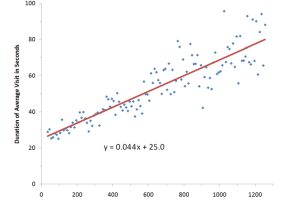As the blog period begins to wrap up, many SC200 students, myself included, are beginning the long process of trying to find blogs who are worthy of our comments. However as I sifted through the endless streams of blog posts covering everything from dogs wagging, to the theory of evolution, I found myself drawn to the shorter ones. That is not to say that the longer ones were worse, but subconsciously I seemed to be skipping right over them in favor of their shorter competitors. This got me thinking am I the only one who does this, or is their actually a phenomenon that I am completely unaware of?
When I began to do research on this topic I found myself doing the exact same thing to the articles I was visiting. I would scan the shorter ones and bounce right off of the longer ones. According to Farhad Manjoo, a writer for Slate.com, “For every 161 people who landed on this page, about 61 of you—38 percent—are already gone” after two sentence. As a writer, the first few sentences seem to be the most important. Infact it seems that people begin to formulate their comments after only the introduction. Readers will not even get to the “nut paragraph” before firing off their own opinions.
(Graph)
In a study done by a group of researchers in 2008, they found what everyone in the writing world already knew. No one stays for long. They found that “10,163 pageviews (17%) that lasted less than 4 seconds. In such brief “visits,” users clearly bounced right out without truly “using” the page.” The rest of the users averaged almost 4.5 seconds per 100 words typed. Since an average adult can only read at “300 wpm” or words per minute. This means that the more you write, the less people seem to read. Infact people only “read about 20% of the text on the average page.”
(Graph)
However all is not lost. There are a few simple things that you can do to get more traffic on your blogs. First off use graphs. Breaking up your articles can help keep the interest of readers up, and give the readers a break. Also use shorter paragraphs. Shorter paragraphs seem to keep readers more engaged. “A story packed with too many long paragraphs looks thick and off-putting. In fact, readers are likely to skip even a single lengthy paragraph.”
In conclusion it seems that I am not alone in my “speed reading.” Most readers on the internet don’t take the time to actually read the content, and only sift in order to find the information they want. This also reinforces the point that the first paragraph is crucial to a writer’s success. So for those who have actually made it to the end of my post, I would like to congratulate you. For those who skipped directly to the end, long story short is keep your posts as short as possible. This will not only attract more readers, but will allow you get your information across to a larger audience.


